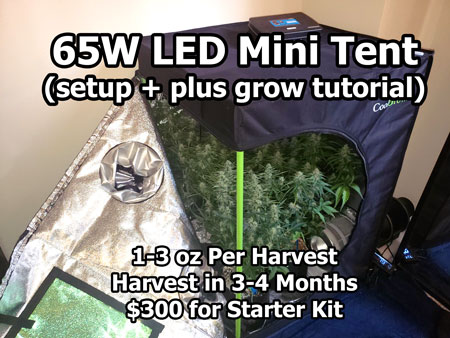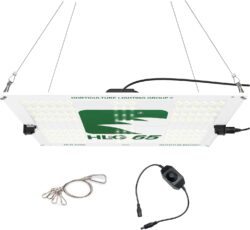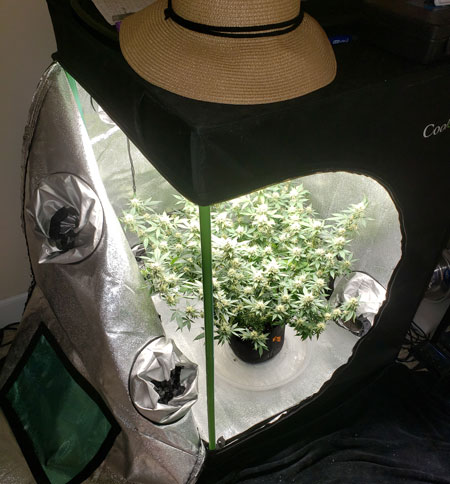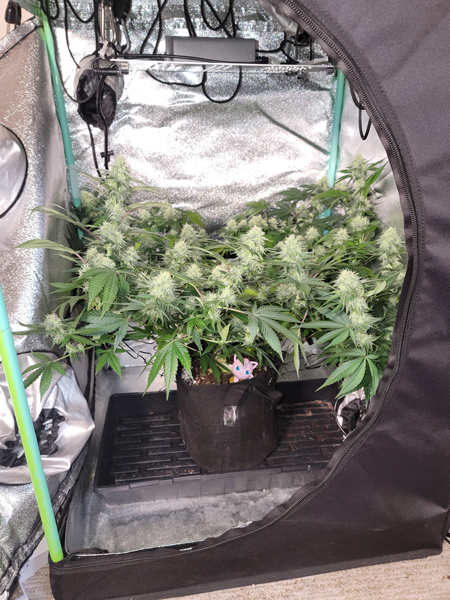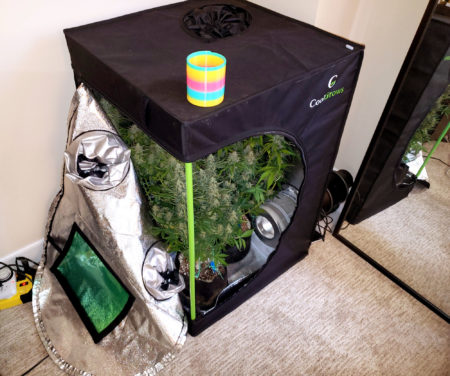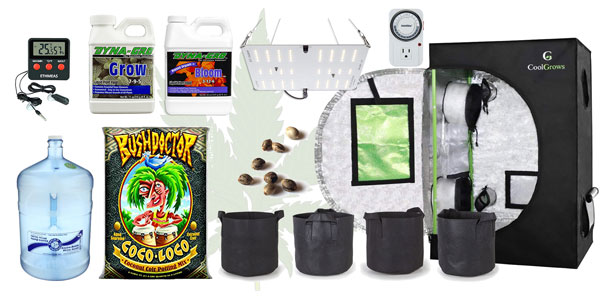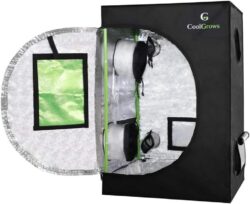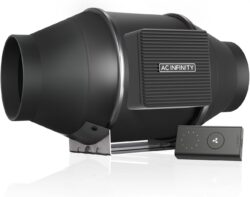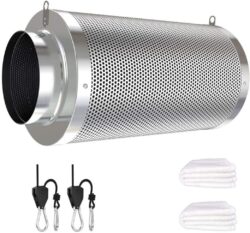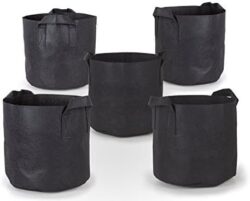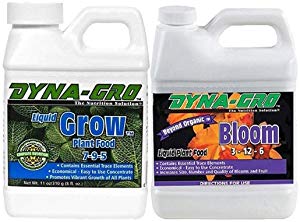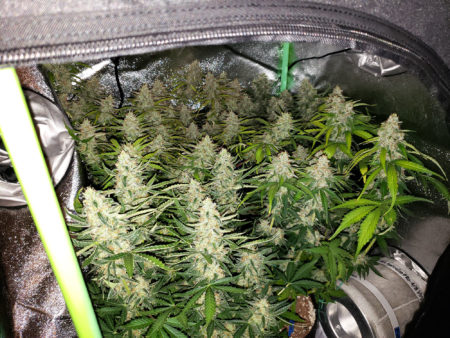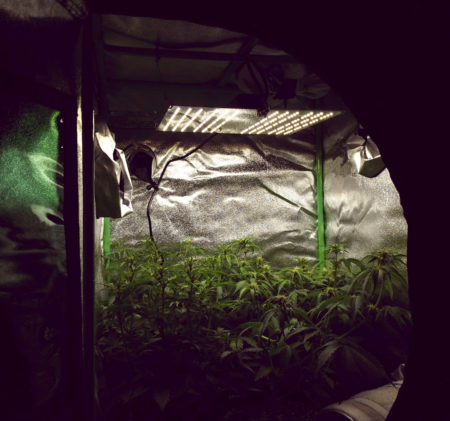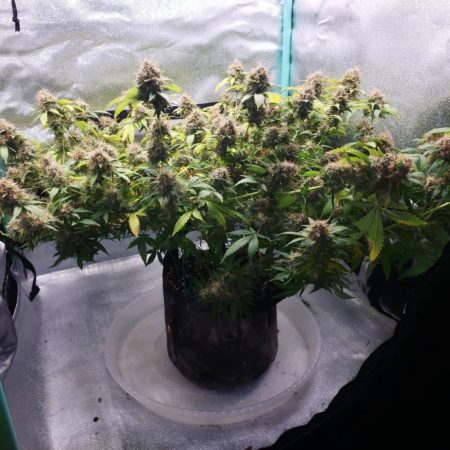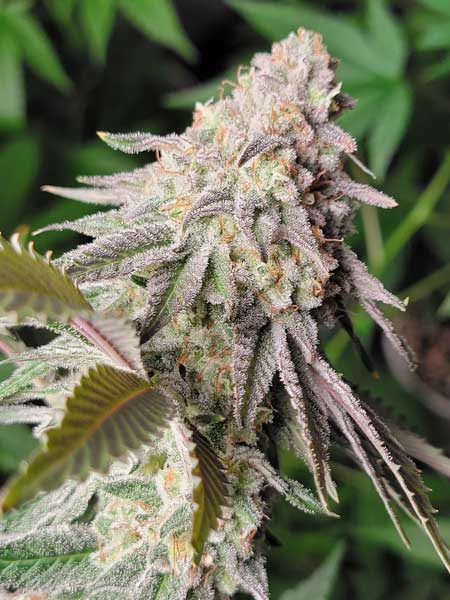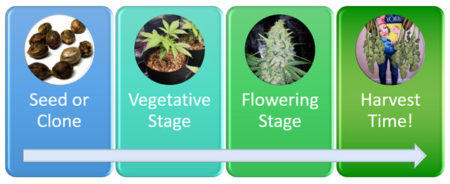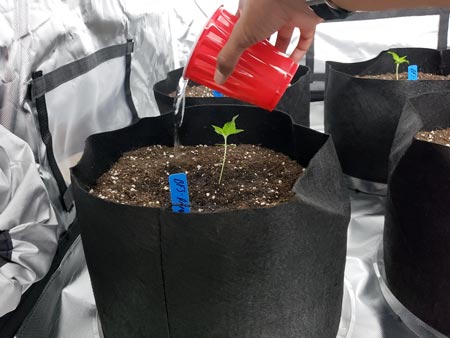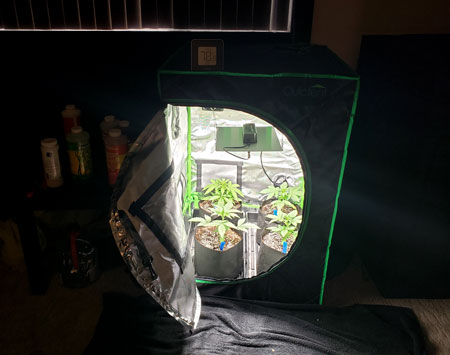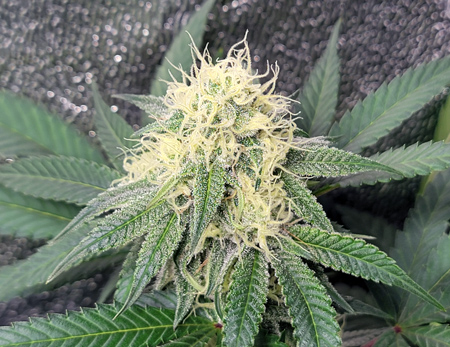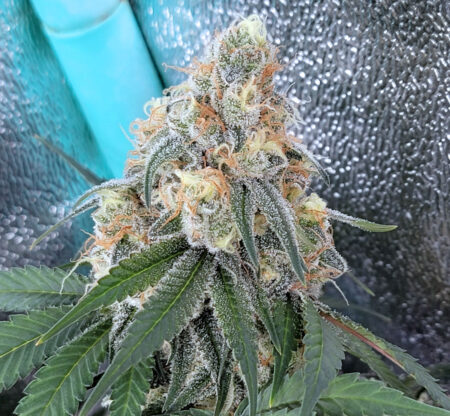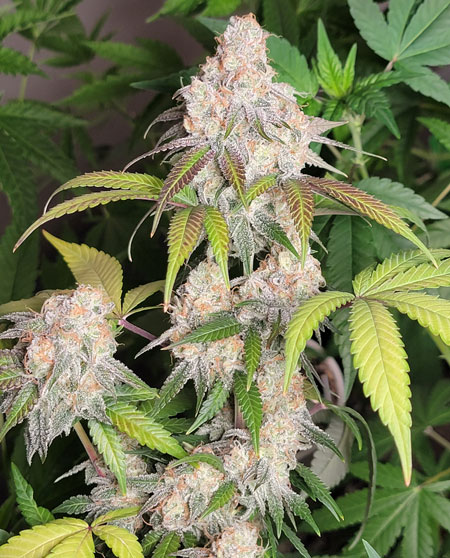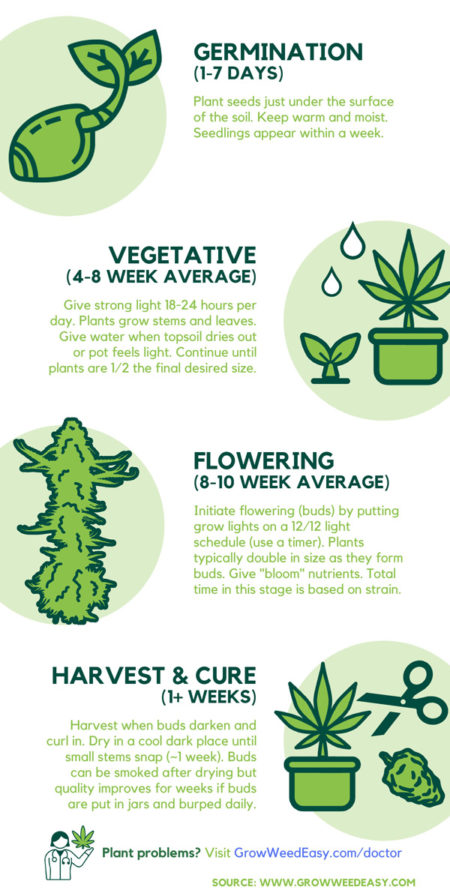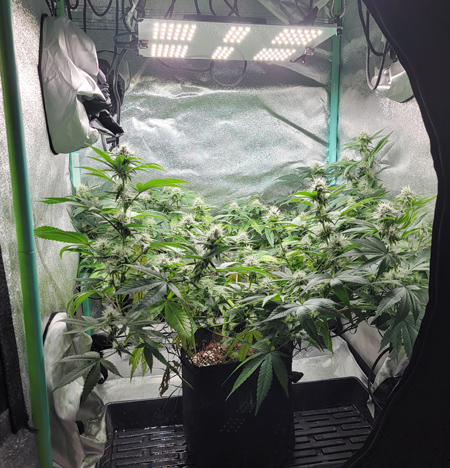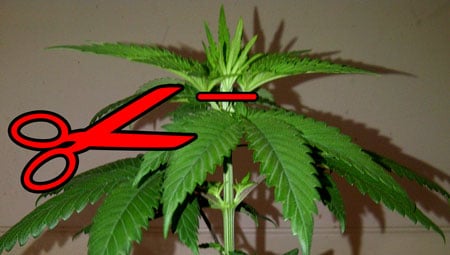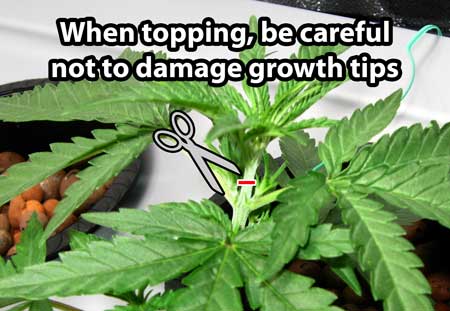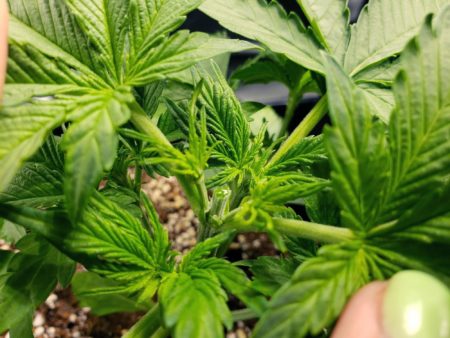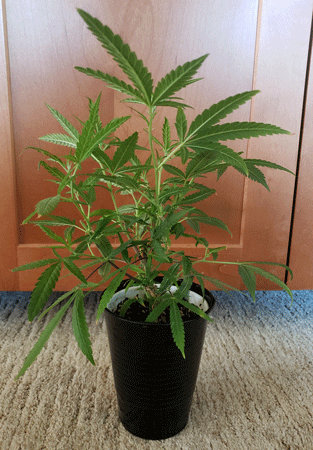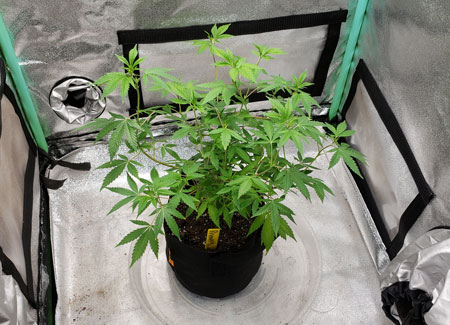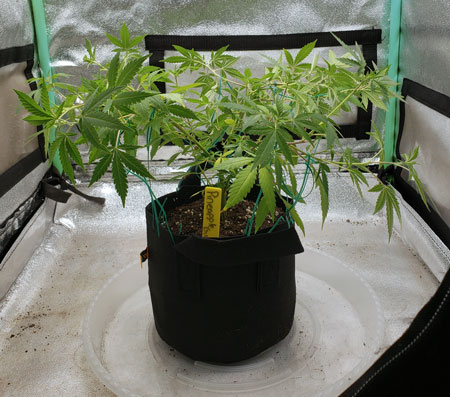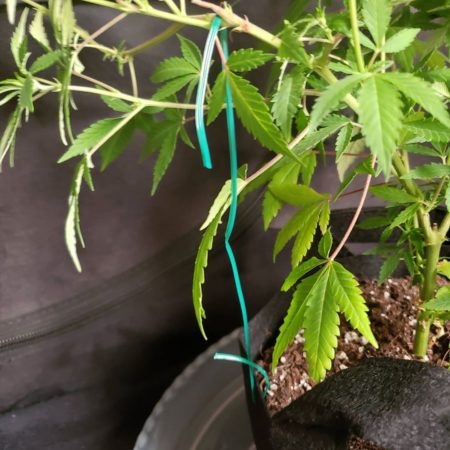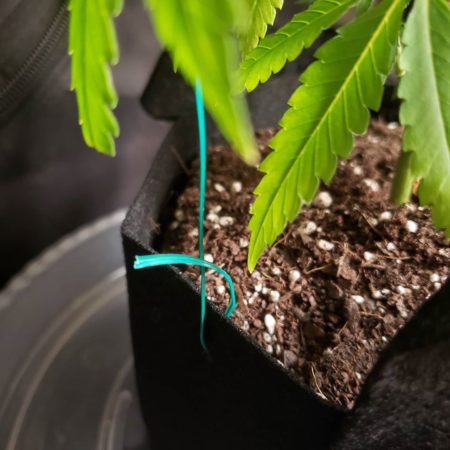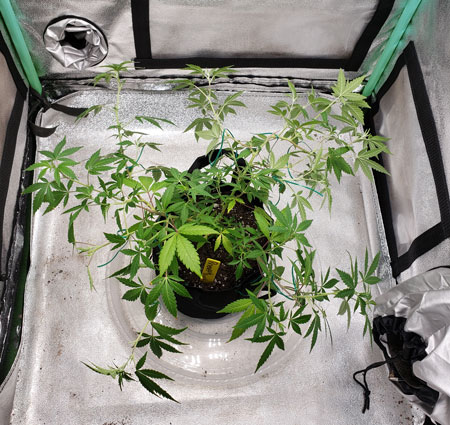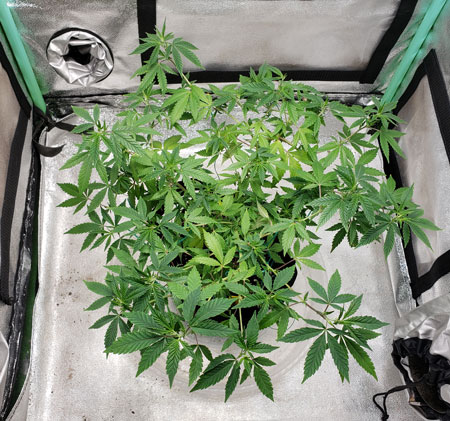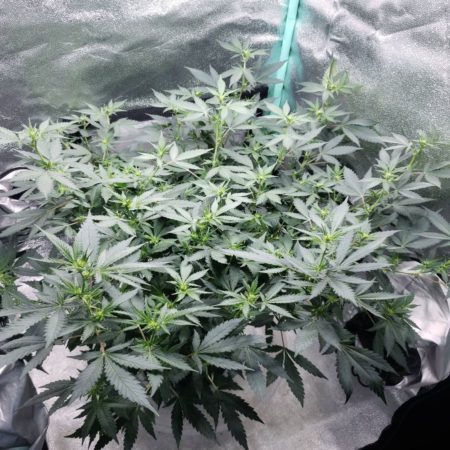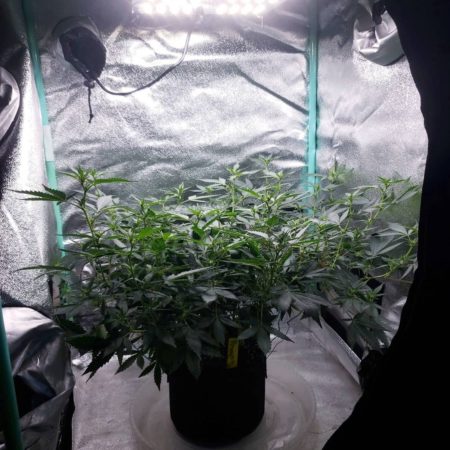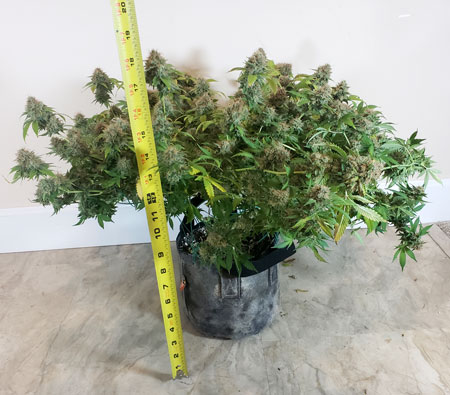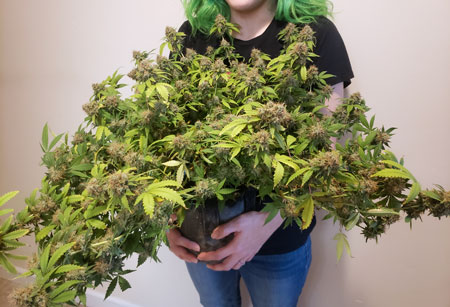by Nebula Haze
Ready to start growing weed for only $300? This tutorial uses the HLG 65 V2 4000k LED in a 3′ tall mini grow tent to produce up to 3 oz of top-shelf cannabis per harvest (at 65W it’s almost free to run this marijuana grow light after set up). This is my absolute favorite grow light for cannabis micro-growing because it produces great bud quality and yields, while the unique 4000k spectrum helps cannabis plants stay short. Essentially, this setup makes a lot of big buds on a little plant. I’ve included a supplies list with Amazon links for this marijuana mini grow tent kit, plus a complete cannabis growing tutorial below. Learn how to achieve these results (it’s easy!) by following the easy step-by-step instructions below.
Note: See Other Examples of Cannabis Growing Setups
Today’s easy growing tutorial is everything you need to get started and get to a bountiful cannabis harvest!
Check out a grow journal in this setup
Table of Contents
- About the Cannabis Mini Tent Setup
- Cost Estimate ($300 to start)
- Complete Supply List
- How to Keep Cannabis Short and Still Grow Big Buds
About This 65W LED Mini Tent Setup for $300
For a micro cannabis grower, it’s all about getting the best yields in the smallest and stealthiest way possible. This mini-tent setup has been designed to produce several ounces of high-quality bud in a tiny 2’x2’x3′ grow tent without any sounds or smells to give it away. It only costs $300 for the bare-bones version without smell filtering and will produce a great harvest in 3-4 months.
- Yield: Up to 3 oz per harvest
- Almost free to run a 65W LED grow light
- 3-4 months from seed to weed
Total Setup Cost: $300 ($420-500 with professional smell filtering)
The HLG 65 V2 (4000k spectrum) can produce several ounces of weed in this setup. Almost free to run at just 65W.
It can support any strain when used according to the directions below, but this marijuana microgrowery setup tends to do best if you choose “short” cannabis strains as they tend to stay smaller.
See other examples of cannabis growing setups
Mini Tent Cannabis Grow Examples
Here are some plants I’ve grown in this exact setup or check out a full grow journal.
One photoperiod plant in a 3-gallon fabric pot
Side view of that plant not long before harvest. Look at all those buds! It ended up yielding about 3 ounces in total.
Three autoflowering plants in 2-gallon fabric pots produced a little over an ounce per plant
Estimated Cost for this Setup
- Ultra budget basic version (bare minimum with no smell filtering) – $300 plus seeds
- Only the necessary stuff + smell filtering: ~$420 plus the cost of seeds (I swear I didn’t do “420” on purpose, it was just meant to be)
- Get everything including the premium equipment and optional extras: ~$500 plus seeds
- Estimated Monthly Electricity Cost: $10/month (based on US average of $0.15/kWH)
Total Setup Cost: $300 ($420-500 with smell filtering)
Summary of what you need to get started with this HLG 65 Mini Tent grow setup
Complete Cannabis Grow Supply List
This cannabis mini grow tent setup list includes all the supplies you need to get to harvest.
65W HLG Quantum Board LED Grow Light
HLG 65 V2 (4000k spectrum)
- The 4000k (blue) spectrum helps keep plants short, which is helpful in this setup
- Keep about 10″ away to start. If plants start getting tall/stretchy, move the light closer.
- Simple to use. Works exactly as you’d expect.
- I’ve gotten some of the best yields per watt with this particular grow light than any other
Cost: $100
The HLG 65 V2 (4000k spectrum) can produce several ounces of weed in this setup.
Grow Space
A grow tent is an easy and cheap way to instantly create a perfect indoor cannabis grow space that can deal with water, light, heat, and smells. Learn more about grow tents
3 Foot Tall Mini Grow Tent
- 2’x2’x3′ (true microgrow) – I use this tent by CoolGrows but the brand doesn’t matter much.
Cost: $40
2’x2’x3′ grow tent by CoolGrows
(Optional to Stop Smells) Exhaust Fan + Carbon Filter
An exhaust fan brings in fresh air to the plants and helps vent extra heat/humidity from the plants. If you are only growing one small plant and don’t care about smell, you can get away without an exhaust fan because the HLG 65 LED doesn’t make much heat. However, if you plan on filling your tent with plants like the pictures, an exhaust fan helps ensure that the humidity from all the plants doesn’t build up too much, which is not good for bud development. If you want to stop smells, you need to get both the exhaust fan and the carbon filter and connect them together (instructions below).
- Recommended: 4″ AC Infinity CLOUDLINE series of inline exhaust fans. These are quiet at top speed and completely silent at lower speeds.
- S4 is the cheaper, simpler version which works well and gives you basic fan speed controls
- The programmable T4 version has handy extras like a Temperature/Humidity Probe and Display Screen
- Budget choice: Vivosun 4″ Fan – 203 CFM (good cheap fan but runs loud)
Cost: $65-120
The AC Infinity S4 is a quiet exhaust fan.
What’s all this about a carbon filter?
- If you don’t hook up a carbon filter to an exhaust fan, your tent may rapidly fill the surrounding area with a pungent weed smell as you get close to harvest. Normally it wouldn’t be such a big deal with such a small tent like this, but you are going to be growing a surprising amount of weed in here.
- Recommended: 4-inch Carbon Filter, 4″ x 10″ version (note: these are bigger than you expect)
- 4″ Ducting and Ducting Clamps – to connect your fan and carbon filter together securely
Cost: $35
4-inch Carbon Filter, 4″ x 10″ version
Soil + Plant Pots
- Growing medium: Coco coir or soil
- Containers: Stick to under 3 gallons in size to help keep plants a bit smaller. I grew with 1-gallon fabric pots, which worked well at keeping plants small, but plants needed to be watered daily. The plants needed to be watered less often when I used 2-gallon pots, but the plants got a little bigger. 3-gallon pots were the easiest to water, but the plant really wanted to grow big and I had to do a lot of bending to keep the branches from growing into the light.
Recommended:
- One big bag of coco-based soil with perlite. This 2 cu ft bag of Coco Loco should be enough to fill 15 gallons worth of pots (for example seven 2-gallon pots with a tiny bit left over). You’ll have enough to last a few grows, but luckily coco-based soils store well so you could use the rest later.
- 2-Gallon fabric pots (here’s an example of a 5-pack) – Any brand works great.
Cost: ~$65
Coco Loco is a coco-based soil that makes thriving cannabis plants

Nutrients
Most nutrient systems will come with at least one bottle for vegetative and one for bloom. Many nutrient lines carry 3 bottles or even more that must be mixed into the water in different ratios over the course of your cannabis plant’s life. Whether it’s on the bottle or online, most nutrient lines come with a schedule. Use the schedule at half-strength in the beginning as the recommended strength is typically too high for cannabis.
Recommended Base Nutrients: Dyna-Gro Grow + Bloom nutrient combo is excellent, cheap, and easy to use for growing cannabis.
- “Grow” bottle: Give 1 tsp per gallon of water during the vegetative stage
- “Bloom” bottle: Give 1 tsp/gallon of water during the flowering stage
Learn about other cannabis nutrients we recommend.
Cost: $25
Dyna-Gro Grow + Bloom is my recommended nutrient system for newbies. One bottle for veg, one for bloom. 1 tsp/gallon. Super simple!
Other Supplementary Items
- Get your seeds (lately I’ve been using Seed Supreme) – $10-15/seed on average, but can be more or less depending on the breeder.
- 24-Hour Timer (to put your grow lights on a timer so the plants get a day and night period on a schedule). Why do cannabis plants need to be on a day/night schedule? What about autoflowering light schedules? – $10
- Water containers (I personally use a 3-gallon or 5-gallon water jug to mix up nutrients, but anything can work) – Much cheaper at Wal-Mart or a water container store ($5-15) than online!
- Thermometer/Humidity Monitor with a probe so you can keep track of the temperature in different parts inside the tent (though less necessary if you got the really fancy Cloudline exhaust fan with a temperature and humidity probe built-in) – $15
- PH Test Kit – Prevent potential nutrient deficiencies by testing the water pH: https://www.growweedeasy.com/ph – $20
- Measuring spoons for measuring out your nutrients (many people already have these) – $10
- (Optional) Zip ties – the hanging apparatus that comes with many grow lights add several inches of height for no real reason. They just aren’t designed for height-limited growing. In a mini tent like this, height is at a premium and a few inches can make a big difference. When you need to get your light all the way to the top of your tent, nothing seems to work better than industrial zip ties! Once you start using zip ties you end up using them for everything. They’re weirdly permanent and strong for something so disposable – $10
Learn about other cool growing tools.
Estimated Cost: $300-500
- Ultra budget (no smell filtering) – $300 plus the cost of seeds
- Only the necessary stuff + smell filtering: $420 (I swear I didn’t do “420” on purpose, it was fate)
- Get everything including the premium equipment and optional extras: $500
Check Out Different Grow Setups!
Carbon filter and fan (how to cool tent, remove humidity, and stop smells)
Notice the configuration of the carbon filter and fan. Even though this is a very small carbon filter, just 10″ long, there’s not a lot of extra room at the top of the tent. The configuration below seems to be the only way I can find to fit the carbon filter inside while still allowing the grow light to get to the top of the tent. This is not as effective as exhausting from the top of the tent, but it will work in this small tent.
Your other option is to put both the fan and carbon filter sitting on top of the tent, exiting from the top port. In that cause, you’d want the carbon filter to be the last thing before air escapes (carbon filters should always be at the ends of an exhaust system, either inside the tent at the beginning, or at the end on the outside).
You have to get creative to fit a carbon filter in this tiny tent
When set up right, you can produce a surprising amount of bud in a tiny space!
Growing a single Pineapple Chunk plant in the 3′ tall tent
Pacific Punch bud grown under the HLG 65 in this setup
How to Make Cannabis Plants Stay Small and Still Produce a Lot of Weed
You may know how to grow cannabis already, and there are lots of great tutorials on the site such as the 10-Step Cannabis Grow Guide, but here’s a super quick overview before we get into the details of how to keep your cannabis plants the perfect height in this setup.
Basic process of growing of an indoor cannabis plant
Germination – there are lots of ways to germinate seeds but the easiest is just to put the seeds directly in the dirt just below the surface (about a knuckle down) and give some water and warmth from the grow light. Seedlings should appear in a few days.
Vegetative stage – When cannabis plants are young, they grow branches and leaves but not any buds. Simply give plants water, light, and possibly nutrients. Nutrients are only necessary if you’re not growing in soil (for example in coco or hydroponics) but even in soil, providing nutrients makes plants grow faster. In the flowering stage, the right nutrients make buds get bigger.
Initiate the flowering stage when the plant is half the final size – Cannabis buds are actually flowers (isn’t that nice?), and you need to “tell” the plant to start making flowers by tricking it into thinking winter is coming. So once plants have reached about half the final desired size, a grower initiates the flowering stage by putting grow lights on a vacation timer so the light turns off for 12 hours a day. This 12/12 light schedule tricks the plant into “thinking” it’s the end of summer and it starts making flowers/buds. If you’re growing an auto-flowering strain, plants will automatically start flowering when they’re 3-5 weeks old, so you don’t need to think about this step or light schedules. This is a general overview. Read the tutorial below to learn exactly how to make cannabis plants the right size for this specific tent.
Flowering stage – Plants start growing white hairs (“pistils”) at the base of each fan leaf and at the tops of branches. These are are the first signs of buds. Plants will about double in height (more or less depending on strain) after the flowering stage is initiated. Auto flowering strains will double in height from when you see white hairs/pistils. But after about 5-6 weeks, the plant will stop getting any taller and the bunches of white hairs will start fattening into solid buds.
New buds look like white hairs
White hairs darken and curl in as buds mature. Buds often start to “sparkle” (depending on strain).
Harvest – The white hairs on all the buds will all darken and curl in when plants are ready to harvest. Check out pictures of ready-to-harvest buds or some people look at the buds under a magnifier to help decide when to harvest. When buds are ready, cut down the branches one by one and hang them upside down in a cool dark place with light ventilation. Often the place you grew the weed is also a great spot for drying it, for example the inside of a grow tent. There are also other ways to dry buds. Once buds are dry, they will easily pop off the branches. At this point the buds can be smoked but if you put them in glass jars the bud quality will continue to improve for several weeks. This process is known as “curing” and helps buds tighten up, smell better, be less harsh, and overall have higher “bag appeal” and be more pleasant to smoke.
Ready to harvest bud. Mature buds are solid with no white hairs. Leaves may turn yellow or purple like autumn leaves (especially directly under the LED grow light).
You can do it!
This infographic I made may be helpful as well (here’s a PDF version)
Now that you know the basics of growing weed, let’s get into the details of how to grow in this mini tent setup.
Bonus Tips for this setup:
- Choose the right strains – no cannabis strains that naturally get big!
- Choose autoflowering strains that are ready to harvest 10 weeks from germination or sooner (these strains tend to stay smaller than longer-flowering strains), especially if it’s specifically listed as tending to stay short.
- Choose photoperiod strains with a 6-7 week flowering period (you will initiate flowering when plants are about 3 weeks old for a total of 10 weeks just like with the autos) and also make sure you’re choosing a strain that says it’s short in the description. Even short strains can get tall, but they tend to grow more out than up compared to other strains.
- Small pots help keep cannabis plants smaller. Use a 2 or 3-gallon pot (or smaller if you don’t mind watering more often) to help plants stay small enough for this setup. Plants can still get big in small pots, but they will be smaller than the same plant if it’s allowed to grow without any restrictions on its roots.
- Follow the instructions below to get the most weed from this setup.
Main Idea: Train plants to grow flat and wide like a table in the vegetative stage.
Tips
- Cut off the top of young plants – Cut off the top of young plants in the vegetative stage. Cutting off the top of a plant is often called “topping” in the cannabis growing world. Topping splits any stem into two, and a plant with two tops is easier to spread out to create flat plants than a plant with one main top
- Beginner tip: Wait until the seedling has grown 6 sets of leaves. Cut off the top through the main stem above the 5th set of leaves (pictures below). Easy and simple, yet won’t stress plants. After being topped, your plant is easier to spread out and naturally grows more bushy and wide.
- Tall stems should also be “topped” – Cut off the ends of any stem that’s growing much faster than the rest. Each new pair of stems grows slower than the original one. Topping is a great tool to curb fast-growing stems in the vegetative stage.
- Spread out – As the plant grows, spread out the stems by bending them down and away from the center of the plant. Don’t forget to tie branches down with something like plant twist tie or they’ll spring right back up the next day!
- Supercrop (if necessary) – Cannabis stems get hard and woody as time goes on. If you find you need to bend a stem that’s already stiff, use the supercropping technique to bend even the toughest stems at any angle. This is a bit advanced because you can accidentally split stems. But don’t worry if you do. Simply tape broken stems back together like a cast and the plant can heal. One of the things I love about cannabis plants is it can recover if you make big mistakes in the vegetative stage.
Here’s an example of training plants to grow wide and flat for more bud sites and bigger yields.
Cut off the top of a young plant right above the 5th set of leaves (“top” the seedling above the 5th node)
When cutting through a stem, be careful not to damage the growing tips at the base of each leaf. These will become your two new stems.
Topping splits the main stem into two. You can see the two new “main stems” on each side of the cut.
Since you waited until the plant had several sets of leaves before cutting a small piece off the top, it will continue growing as if nothing happened.
As the plant grows, spread out the branches and cut off the top of any stem that’s getting bigger than the others. You don’t want your plant putting too much energy into any one branch.
The plant was transplanted to a mini grow tent under an HLG 65 4000k LED grow light and given a week to adjust to the new environment.
Training time!
Bend over all the stems down and away from the center until it looks flat from the side
I used plant twist tie to hook on to each branch and tie it down where I wanted. I attached the other end to the fabric pot.
How to attach to the pot? You can use safety pins or binder clips but I think this is easier. Poke holes in the fabric using sharp pointy Fiskars pruning scissors and thread the twist tie through.
Back to training. Here’s a top view. We’re trying to fill the entire tent with this plant.
A few days later the plant has filled in nicely. Repeat the steps until you’ve filled your entire grow space.
Initiate 12/12 when plants have complete coverage at the height you want. Look at all the bud sites on this 1 plant right as it starts flowering
Here’s a side view. At this point, the only thing to do is water the plant and give it nutrients until harvest.
At harvest, this plant was just over 18″ (46 cm) tall, yet yielded several ounces because it was trained to grow wide and flat. Talk about making the most out of one small plant!

